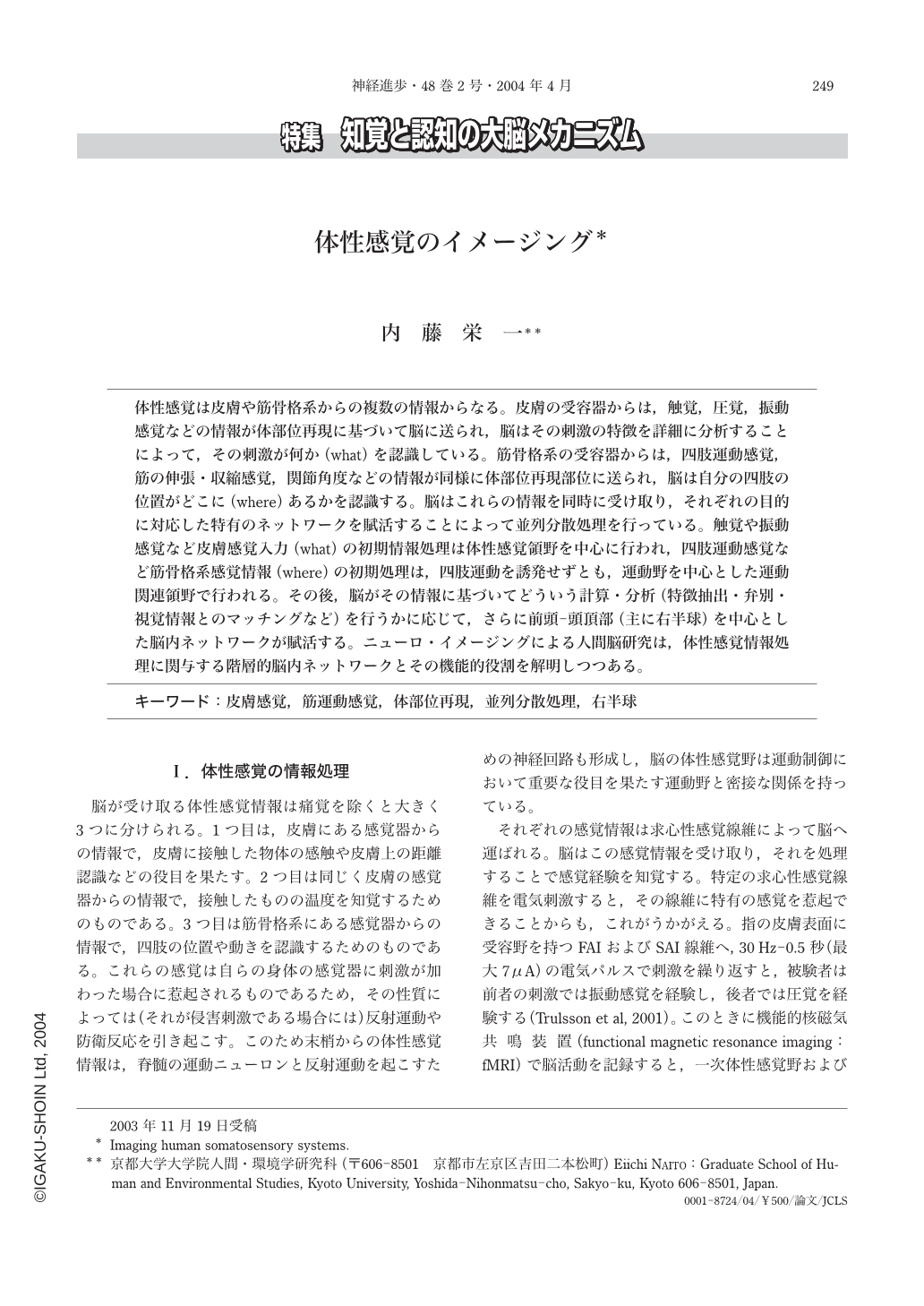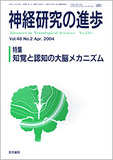Japanese
English
- 有料閲覧
- Abstract 文献概要
- 1ページ目 Look Inside
- サイト内被引用 Cited by
体性感覚は皮膚や筋骨格系からの複数の情報からなる。皮膚の受容器からは,触覚,圧覚,振動感覚などの情報が体部位再現に基づいて脳に送られ,脳はその刺激の特徴を詳細に分析することによって,その刺激が何か(what)を認識している。筋骨格系の受容器からは,四肢運動感覚,筋の伸張・収縮感覚,関節角度などの情報が同様に体部位再現部位に送られ,脳は自分の四肢の位置がどこに(where)あるかを認識する。脳はこれらの情報を同時に受け取り,それぞれの目的に対応した特有のネットワークを賦活することによって並列分散処理を行っている。触覚や振動感覚など皮膚感覚入力(what)の初期情報処理は体性感覚領野を中心に行われ,四肢運動感覚など筋骨格系感覚情報(where)の初期処理は,四肢運動を誘発せずとも,運動野を中心とした運動関連領野で行われる。その後,脳がその情報に基づいてどういう計算・分析(特徴抽出・弁別・視覚情報とのマッチングなど)を行うかに応じて,さらに前頭-頭頂部(主に右半球)を中心とした脳内ネットワークが賦活する。ニューロ・イメージングによる人間脳研究は,体性感覚情報処理に関与する階層的脳内ネットワークとその機能的役割を解明しつつある。
Recent imaging techniques have provided novel and striking evidences in sensorimotor systems of the human brain. It is now microstructurally revealed that human primary somatosensory and motor cortices can be cytoarchitectonically subdivided as areas 3a, 3b, 1, 2, 4a and 4p(Geyer et al., 1996, 1999), as shown in non-human primates. This anatomical correspondence between species allows us to directly relate human imaging data to non-human electrophysiological data. Functional neuroimaging studies have also revealed striking evidences for brain's developmental capacity of neuronal plasticity that visual cortices including primary visual cortex of blind people participate in somatic processing(Sadato et al, 1996).
Humans, as non-human primates, have various types of cutaneous and skeleto-muscular receptors and their sensory afferents send their specific somatic information to the brain. The brain receives and processes these afferent inputs in a goal-directed manner.
Cutaneous inputs(vibrotactile, touch, pressure), especially from hands, are often processed in the brain to analyze features of a provided stimulus i.e.‘what'is the stimulus. These sensory inputs activate somatotopical sections of primary somatosensory cortex(cytoarchitectonic areas 3b and 1)where initial processing of these information takes place. When the brain needs further analysis of stimulus features, this neuronal computation engages additional brain areas, e.g. analysis of curvature or shape of a touched object engages area 2 and parietal cortices(intraparietal cortex and supramarginal gyrus)(Bodegard et al, 2001).
In contrast, kinesthetic(proprioceptive)inputs signaling limb movements or limb position are processed to recognize‘where'is my limb. These inputs also activate somatotopical sections, but in the cortical motor areas[primary motor cortex(M1;areas 4a and 4p), premotor cortex(PM), supplementary motor area(SMA), cingulate motor area(CMA)]rather than somatosensory cortex(Naito et al, 1999, 2002a;Naito, 2004). In particular, M1, which has been regarded as an executive locus of limb movements, is also primarily involved in kinesthetic perception of limb movements even in a situation that limbs remain immobile(Naito et al, 2002a). These evidences show that central processing of cutaneous or skeleto-muscular information engages specific brain networks in which‘what'(cutaneous)or‘where'(skeleto-muscular)computation takes place in human somatosensory system.
Functional imaging techniques have their technical advantages of measuring neuronal activity in the whole brain. These techniques have revealed a possible engagement or functional roles of non-primary brain areas in sensory tasks, which have been rarely investigated by electrophysiological single cell studies. Frontal(premotor cortex, cingulate cortex, areas 44 and 45, frontal operculum, insular cortex, prefrontal cortex)and parietal regions(intraparietal cortex, supramarginal gyrus, parietal operculum), preferentially in the right hemisphere, are often engaged in tasks requiring somatic processing irrespective of cutaneous or kinesthetic information(Coghill et al, 2001;Kawashima et al, 2002;Naito et al, 2002a). Functional roles of these non-primary areas are still uncertain, however, these areas would be involved in higher somatic functions such as active exploration, sensory monitoring, somatic working memory and sensory matching with other modalities. And the preference of right hemisphere for somatic processing may permit simultaneous usage of language and monitoring of somatic functions.
Neuroimaging studies in human somatosensory systems are now uncovering veils hiding hierarchical organization of multiple brain networks and their functional roles.
(Received:November 19, 2003)

Copyright © 2004, Igaku-Shoin Ltd. All rights reserved.


